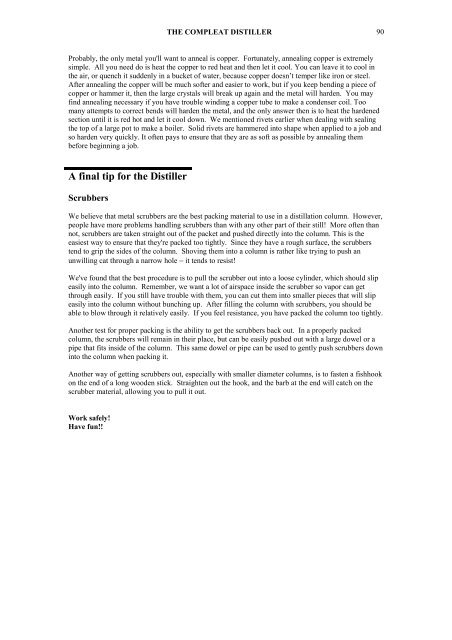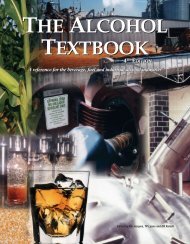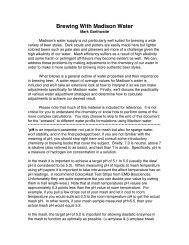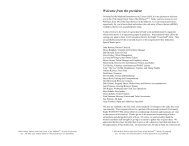The Compleat Distiller
The Compleat Distiller
The Compleat Distiller
You also want an ePaper? Increase the reach of your titles
YUMPU automatically turns print PDFs into web optimized ePapers that Google loves.
THE COMPLEAT DISTILLER 90<br />
Probably, the only metal you'll want to anneal is copper. Fortunately, annealing copper is extremely<br />
simple. All you need do is heat the copper to red heat and then let it cool. You can leave it to cool in<br />
the air, or quench it suddenly in a bucket of water, because copper doesn’t temper like iron or steel.<br />
After annealing the copper will be much softer and easier to work, but if you keep bending a piece of<br />
copper or hammer it, then the large crystals will break up again and the metal will harden. You may<br />
find annealing necessary if you have trouble winding a copper tube to make a condenser coil. Too<br />
many attempts to correct bends will harden the metal, and the only answer then is to heat the hardened<br />
section until it is red hot and let it cool down. We mentioned rivets earlier when dealing with sealing<br />
the top of a large pot to make a boiler. Solid rivets are hammered into shape when applied to a job and<br />
so harden very quickly. It often pays to ensure that they are as soft as possible by annealing them<br />
before beginning a job.<br />
A final tip for the <strong>Distiller</strong><br />
Scrubbers<br />
We believe that metal scrubbers are the best packing material to use in a distillation column. However,<br />
people have more problems handling scrubbers than with any other part of their still! More often than<br />
not, scrubbers are taken straight out of the packet and pushed directly into the column. This is the<br />
easiest way to ensure that they're packed too tightly. Since they have a rough surface, the scrubbers<br />
tend to grip the sides of the column. Shoving them into a column is rather like trying to push an<br />
unwilling cat through a narrow hole − it tends to resist!<br />
We've found that the best procedure is to pull the scrubber out into a loose cylinder, which should slip<br />
easily into the column. Remember, we want a lot of airspace inside the scrubber so vapor can get<br />
through easily. If you still have trouble with them, you can cut them into smaller pieces that will slip<br />
easily into the column without bunching up. After filling the column with scrubbers, you should be<br />
able to blow through it relatively easily. If you feel resistance, you have packed the column too tightly.<br />
Another test for proper packing is the ability to get the scrubbers back out. In a properly packed<br />
column, the scrubbers will remain in their place, but can be easily pushed out with a large dowel or a<br />
pipe that fits inside of the column. This same dowel or pipe can be used to gently push scrubbers down<br />
into the column when packing it.<br />
Another way of getting scrubbers out, especially with smaller diameter columns, is to fasten a fishhook<br />
on the end of a long wooden stick. Straighten out the hook, and the barb at the end will catch on the<br />
scrubber material, allowing you to pull it out.<br />
Work safely!<br />
Have fun!!









